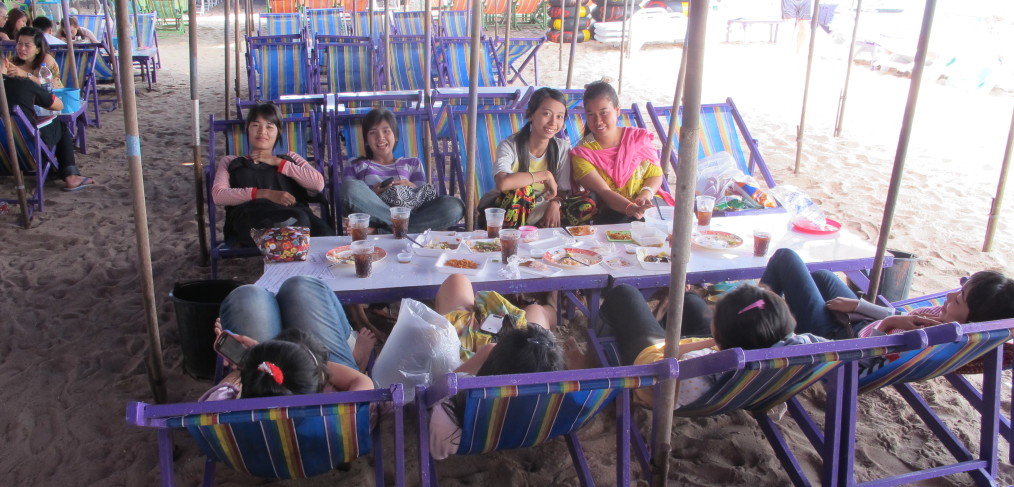
The Beach Rediscovered
The Beach Rediscovered
Mark Bibby Jackson sets off for the Thai royal resort town of Hua Hin searching for the beach he encountered on his first visit to Asia.
We all have that beach: the one etched in our memory so vividly that it transports you back to a time when you were still young, and travelling was an endless adventure. Mine was Hua Hin.
Twenty-one years ago — even before Alex Garland had written The Beach — the town was just a stop-off on the way back from Hong Kong on my first trip to Asia. A short bus ride from Bangkok and I was standing on my own plot of sand with nothing to disturb me but an occasional seagull. At least that’s how I recollect it.
What is without doubt is the old man who took me to the beach in his cyclo. I had to get out each time we approached a hill and walk to the crown. Such things are inconceivable now, as cyclo drivers are in as short supply as deserted stretches of sand.
Although nowhere near as congested as Pattaya, Phuket or Samui, the once sleepy royal resort town is now riding on the shirttails of the Thai tourism trade.
For some this is not yet enough. Sammy Carolus, the general manager of the Hyatt Regency, still feels there is room for expansion.
Enjoying a cocktail at the resort’s McFarland House, a two-storey 19th century pavilion transformed into an airy beachfront bar and dining area overlooking the Gulf of Thailand, he explains his hopes for more international flights so that Hua Hin can compete with the more famous resort islands to the south.
According to Carolus, Hua Hin’s runway is longer than Koh Samui, although its only international flights are from Kuala Lumpur, and it is the growth of condominiums that compete with his repeat trade and stand empty for weeks on end that should be stunted.
An early morning stroll reveals that Hua Hin no longer resembles the beach I remember. Condominiums and luxury resorts stretch down to the still communal sands. Loungers wait in line for Northern European travellers starved of sun. Books, sunglasses and T-shirts demark those already reserved in the time honoured tradition of the Costa del Sol.
Ironically, given its coastal location, the peace and quiet of Hua Hin is now reserved for pastures away from the main drag. The Hyatt Regency has ample gardens in which guests can doze off between pages of the latest best-seller underneath the shade of a tree. Another luxury resort, the Anantara Hua Hin, has an exclusive lagoon where the privileged few can enjoy complimentary cocktails while gazing across lotus leafs from the sanctuary of their pool.
The less fortunate, crowded in their beachfront compounds, must head for the hills. In search of tranquility, I set off for the Hua Hin Hills Vineyard more in faith than in hope. Thai wine is not something I have yet acquired a taste for. However, after reaching the former elephant corral that is now home to Monsoon Wines, it is clear why the owners chose this location. The view is quite spectacular.
The vineyard still has a few elephants on its grounds – the only such one in the world, I am informed by Hanna Oberauer the vineyard’s assistant marketing manager. These are ideal for keeping the kids entertained while mum and dad set about the serious task of sampling the wines. To my surprise, the slightly sweet wines compliment the spice of Thai cuisine.
Tranquil, beautiful and refreshing as the vineyard might be, it still is not a beach. So I head back to the coast once more. Some 20 or so kilometres further north than its regal neighbour, the fishing town of Cha Am still possesses a charm that Hua Hin despite, or perhaps because of, its luxury resorts seems to have lost.
Here you can spend a lazy Sunday afternoon sat in a deckchair in the shade of an umbrella eating seafood and downing a bottle of beer. Only the spicy food and the temperature of the beer separate it from the traditional British resorts of my childhood. If I had a handkerchief I would knot it around my head.
The beach is full of locals trying to prevent their skin from darkening under multi-coloured umbrellas, while the narrow beach has an equal number of western tourists aiming for precisely the opposite effect.
A further few kilometres north lies my final destination. Designed by Thai architect Duangrit Bunnag, the Hotel de la Paix has gleaned much deserved praise for its contemporary yet minimalist design. Less is said about its beach. It might not be that of legend — such as might send Leonardo Di Caprio rafting across oceans to discover — but it is the same beach, only transported a few kilometres north, as I remember from my first trip to Asia all those years ago.
Heeding the lessons of Pattaya and beaches further south, Cha Am’s governor wishes to preserve the integrity of its town and surrounding beaches, the resort’s general manager Nigel Tovey explains.
With every step further north the sands become emptier. An occasional dog with its owner passes me, taking advantage of the refreshing air that comes with the setting of the sun. The beach continues off into the distance, for some seven or so kilometres — far enough at any rate. Occasional buildings, a couple of resorts, vacant plots awaiting far-sighted property speculators dot the area, but above all it is a deserted beach.
My quest over, I can return to Bangkok wondering why nobody has trodden the same steps as mine. Or maybe they have and it’s just that Cha Am’s governor has only passed his secret on to the owners of the Hotel de la Paix and its lucky few guests.

